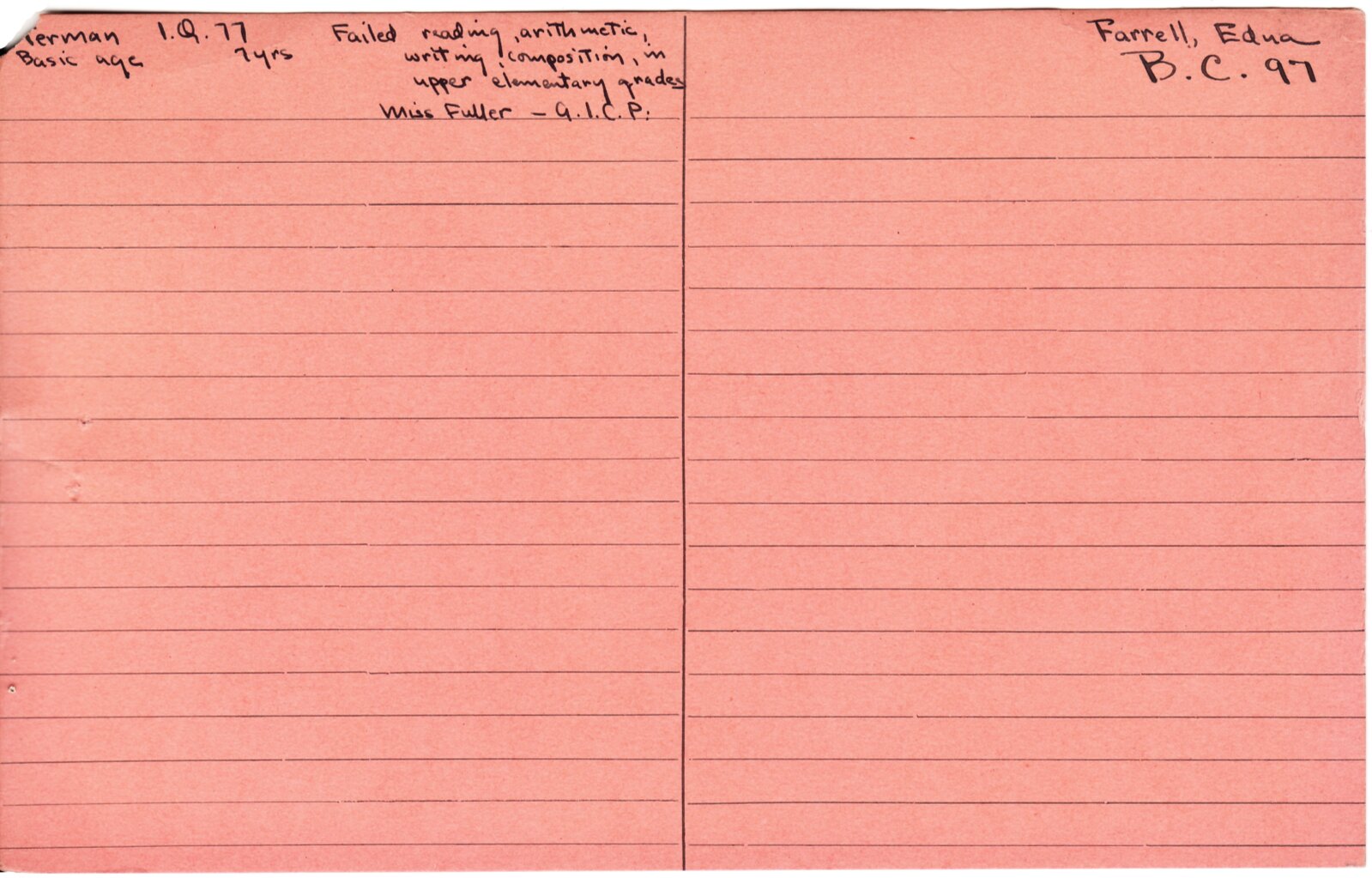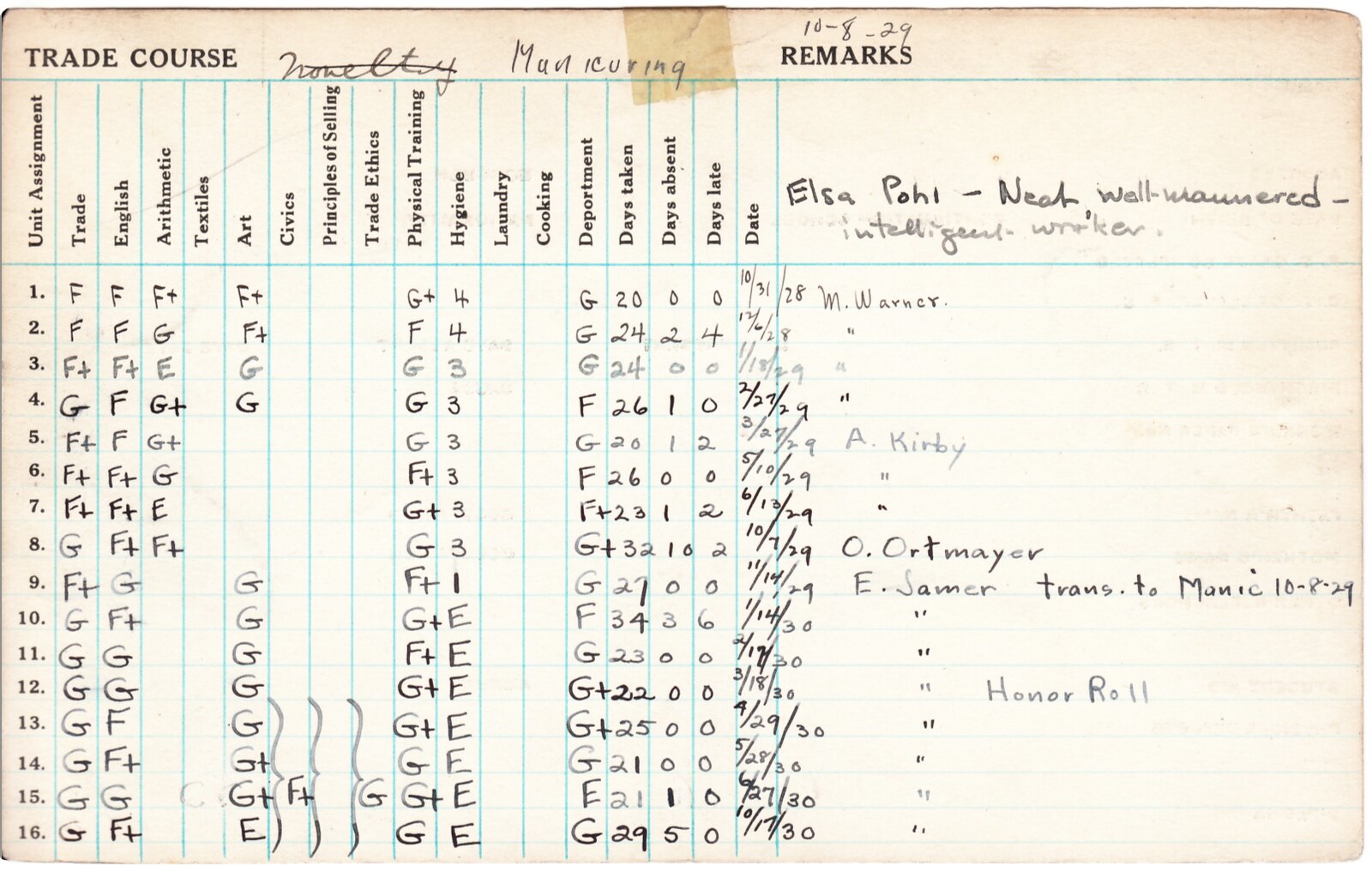
For the second consecutive week, we're going to examine the Manhattan Trade School student record of a girl named Edna. Last week it was Edna Carrington; this time around it's Edna Farrell, whose main card is shown above. As you can see, was born in 1912 (and is therefore likely deceased, or else turned 102 just a few weeks ago) and grew up in Harlem.
There are two notable entries on this card. First, Edna's father, George, is listed as a sheep butcher. That's an interesting degree of specificity — I have several other cards that list a father's occupation simply as "butcher," but a sheep butcher seems unusually specialized.
Also, look at the upper-right corner, which is where the student's chosen trade is listed. For Edna, it shows two entries: one year of "Nov.," which is novelty box making (one of the "glue trades" that the school taught), and one year of "B.C.," which is beauty culture, a course of study that the school added in the late 1920s to supplement its longstanding focus on the needle and glue trades.
Normally I'd turn this card over and take a look at Edna's grades, but first I want to look at another card from her file — take a look:

The information here is sparse but telling. The card lists Edna's IQ at 77 and her "basic age" at seven years. It also says she "failed reading, arithmetic, writing [and] composition in upper elementary grades."
So how did this supposedly intellect-challenged girl who failed her way through grade school do in her classes? Let's take a look at her grades (remember, E = Excellent; G = Good; F = Fair; P = Poor):

As you can see, Edna did just fine — and often a lot better than fine — in all of her classes, including English and arithmetic. She also repeatedly made the Honor Roll and was described as an "intelligent worker." Not bad for someone with a "basic age" of seven, eh?
Meanwhile, look at the top of the card — "Novelty" was crossed out and replaced by "Manicuring." Similarly, the middle of the far-right column has a notation indicating that Edna "trans. to Manic." This reinforces what we saw on the first card — Edna took one year of novelty box making and one year of beauty culture.
Edna's file also includes the record of the jobs that the school arranged for her:

There are several points of interest here. One at a time:
1. All of the business are categorized as "B.C.," which presumably once again refers to beauty culture. One of Edna's employers was called Ralph Beauty Shop, so that fits. But the first business was called Stewart's, which was probably a Stewart's Candy Shop (a popular chain at the time), and the final entry is for a medical center, neither of which fits in the beauty category — yet they're both listed as "B.C." There's also a "hairdresser" reference, but it's unclear which entry it's referring to. Hmmmm.
2. At Ralph Beauty Shop, Edna was a finger waver (this refers to the then-popular hairstyle known as a finger wave), oil shampooer, and manicurist.
3. Edna left the job at Stewart's because it was "too far" — not surprising, given that she lived way uptown in Harlem and the job was in Brooklyn. (By coincidence, the address listed for the job, 221 Flatbush Ave., is a short walk from where I live — or it would be, if it still existed. There's no longer any building with that address. The street numbers on adjacent buildings on that block now jump from 215 to 227.)
4. The notations in red are comments from one of Edna's employers — Ralph Beauty Shop. Oddly, they're out of chronological order. I've put them in the proper sequence and transcribed them like so:
March 18, 1931: Very slow. Takes 50 to 60 minutes for a manicure.
Dec. 21, 1931: Here. OK. [This is a common entry in the work records. It means the employer is basically affirming to the school that the student is showing up for work and performing adequately. — PL]
Oct. 31, 1932: Fair worker.
March 8, 1933: May have to cut Edna's salary to $10 [per week]. Business is very bad.
The final red entry, "Ref. by Mr. Ralph," suggests that Edna got her job at the medical center on Riverside Dr. as the result of a referral from Mr. Ralph, the beauty shop owner.
Edna's file also includes a sheet of paper that may have been a transcript. This sheet appears in a handful of the other student records in my collection, but I haven't been able to suss out its purpose. As you'll see, it's a frustrating document — cut off at both sides and only partially filled out:

That's all I have for Edna. If anyone has more information about her, please get in touch.

A finger wave was a technique used to give a typical hair style of that time period. It's short hair with undulating waves (like the "flappers" wore).
ReplyDeleteThanks, Lianne -- I'll update the text accordingly!
ReplyDeleteIt looks like the last document is an official transcript of sorts because it matches her "report card." Perhaps the report card was for office use and the transcript was to submit to employers or other schools, etc? The 70% in Civics = F+ and the 75% in Trade Ethics = G etc ...
ReplyDeleteLoving these entries, Paul. Here's a long definition of "finger waver" from a company that provides salary data on many different occupations. http://bit.ly/1yXCyFE
ReplyDeleteI've just done a (accidentally much longer than anticipated) bit of googling and reading up on early 20th-century, big-city butchery practices, and it turns out that butchers were highly specialised at that time. A hog man dealt only with hogs; a sheep man dealt only with sheep. The butchers' unions were organised by animal. It seems that a butcher would start off doing a bit of everything, then specialise as they got more skilled. (It makes sense, I suppose. You're bound to be faster at getting meat off a leg bone if you only deal with the one weight and size of leg, for instance.) So, it's likely that, if you met a skilled butcher, he would let you know exactly what sort of butcher he was.
ReplyDeleteBut why did the school record the specialism only in this case? Perhaps Edna's father was extra keen to stress his level of skill so that the school knew that his daughter (who presumably appeared to be somewhat slow) didn't come from a whole family of people with IQs of 77. Who knows?